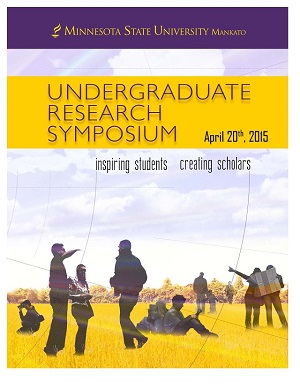Studying the Cellular Mechanism of Muscle Structure in Caenorhabditis Elegans
Location
CSU Ballroom
Start Date
20-4-2015 10:00 AM
End Date
20-4-2015 11:30 AM
Student's Major
Biological Sciences
Student's College
Science, Engineering and Technology
Mentor's Name
Kelly Grussendorf
Mentor's Email Address
kelly.grussendorf@mnsu.edu
Mentor's Department
Biological Sciences
Mentor's College
Science, Engineering and Technology
Description
Muscle is a vastly important tissue found in most animals, performing functions that are critical to sustaining life, formed once during an organism’s lifetime and are subject to weakening and death if not probably maintained. One group of human diseases that embodies this principle is muscular dystrophies. These diseases range in severity but all are characterized by progressive muscle weakness, defects of muscular proteins, and eventual death of muscle cell and tissue. Our interest is a gene that has been shown to cause Limb Girdle muscular dystrophy when mutated or disrupted. Our overall goal is to address the molecular mechanisms that are disrupted in different muscular dystrophy disorders. The mechanism of cell and tissue maintenance is not a simple one; there are many different pathways and proteins that must function as a unit. Trafficking, the movement of material around the cell is one important mechanism for maintaining structures in cells and tissues. Our aim is to utilize previously developed tools and nine subcellular markers to investigate the subcellular mechanisms of trafficking that contributes to muscle cell regeneration. The model organism Caenorhabditis elegans will be used. The nine subcellular markers that are of interest are involved in various ways of transport are: CHC-1, RAB-5, EEA-1, RAB-7, RAB-11, RME-1, GLO- 1, GRIP, and CDC-42. All nine markers are linked to mCherry allowing us to study the subcellular compartments under fluorescence in living organisms. C. elegans several molecular techniques were carried and we have performed the cloning techniques for four subcellular markers.
Studying the Cellular Mechanism of Muscle Structure in Caenorhabditis Elegans
CSU Ballroom
Muscle is a vastly important tissue found in most animals, performing functions that are critical to sustaining life, formed once during an organism’s lifetime and are subject to weakening and death if not probably maintained. One group of human diseases that embodies this principle is muscular dystrophies. These diseases range in severity but all are characterized by progressive muscle weakness, defects of muscular proteins, and eventual death of muscle cell and tissue. Our interest is a gene that has been shown to cause Limb Girdle muscular dystrophy when mutated or disrupted. Our overall goal is to address the molecular mechanisms that are disrupted in different muscular dystrophy disorders. The mechanism of cell and tissue maintenance is not a simple one; there are many different pathways and proteins that must function as a unit. Trafficking, the movement of material around the cell is one important mechanism for maintaining structures in cells and tissues. Our aim is to utilize previously developed tools and nine subcellular markers to investigate the subcellular mechanisms of trafficking that contributes to muscle cell regeneration. The model organism Caenorhabditis elegans will be used. The nine subcellular markers that are of interest are involved in various ways of transport are: CHC-1, RAB-5, EEA-1, RAB-7, RAB-11, RME-1, GLO- 1, GRIP, and CDC-42. All nine markers are linked to mCherry allowing us to study the subcellular compartments under fluorescence in living organisms. C. elegans several molecular techniques were carried and we have performed the cloning techniques for four subcellular markers.
Recommended Citation
Adamek, Marianne and Jessica Bauman. "Studying the Cellular Mechanism of Muscle Structure in Caenorhabditis Elegans." Undergraduate Research Symposium, Mankato, MN, April 20, 2015.
https://cornerstone.lib.mnsu.edu/urs/2015/poster_session_A/18



